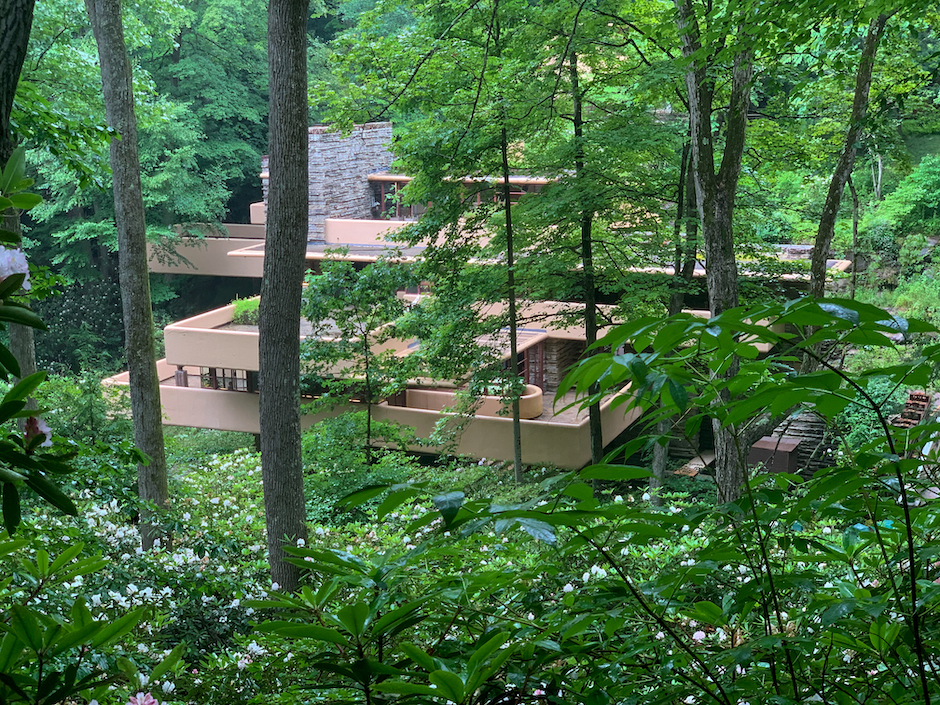
When considering the places I wanted to visit on this trip across the country I immediately thought of Fallingwater. I wanted to experience being there in a way that was more than just the classic picture-perfect view. Mostly I wanted to see and hear what the waterfall was like from inside the house.
I first learned about Fallingwater while taking an architecture class in high school. A house with a waterfall running through it was the coolest thing to my teenage self. The house and lush forest that surrounded it was from a world so different then the identical track ranch houses that lined the street I grew on. I vowed that someday I needed to visit. In college I learned more about its significance as a celebration of the landscape, creativity and the ingenuity of engineering. What intrigued me the most was its influence on modern architecture. After Fallingwater the way we viewed the relationship between people, architecture and nature would never be the same. Over the years I have visited many of Wright’s creations throughout the country. I even drive by a few regularly on my errands around Los Angeles. Yet I still had not explored Fallingwater. This trip was the time.
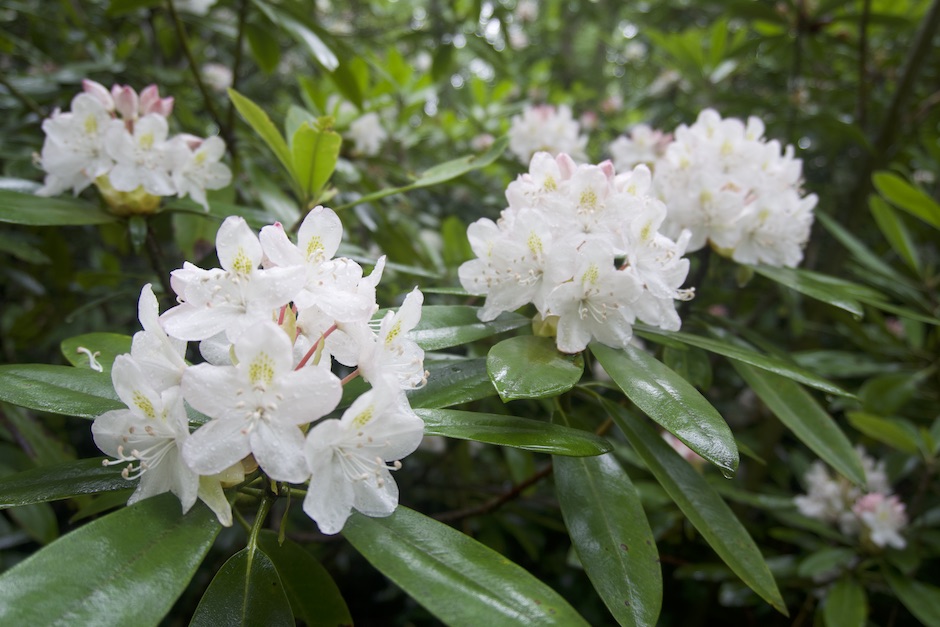
I considered the best time to visit. July would be nice with the sun shining and the wild rhododendrons blooming. I would make an appointment for a tour around 3PM and we would spend some time exploring the grounds and see the late afternoon light highlighting the drama of the water’s reflections and the shadows. As the sun set in the evening, we would observe the bright lights inside the house highlighting the interior as the landscape faded. The vision constructed in my head was the experience awaiting us.
I soon learned that my mental model was not reality. Fallingwater was closed and had been for a year due to the pandemic. The website said to keep checking to see when it would open again. So, on a weekly basis I went to the website and the day they opened for ticketing all of the one-hour indoor guided tours were booked. Months in advance. The only tickets available for the summer were the outdoor self-guided tours for very early morning. We couldn’t arrange the visit around our trip but instead arranged the trip around our tickets.
We arrived in the Laurel Highlands to people waving to us from their porches on a beautiful sunny afternoon the day before our visit. We biked on a rail trail in Ohiopyle and watched people white water rafting on the raging river. We set up our tent in our campsite in Ohiopyle State Park, made smores, and set the alarm for sunrise.
On the morning of our tour, we awoke to a soaked tent and a downpour of rain. I was so disappointed. My first thoughts were, What about the light? The shadows? The reflections? Would they even be open today? Then I remembered our wedding day. That day too was pouring rain and our backup plan was just as special.

We drove there, through the undulating green patchwork hills amidst moody layers of fog. In 15 minutes, we arrived at the Fallingwater engraved sign marker on the road and drove through a dense diverse Appalachian oak forest to the parking lot. The cars displayed numerous state license plates that we wrote down and added to our license plate collection list. We grabbed our umbrellas, passed the UNESCO World Heritage Site plaque and took a short walk to Visitors Center. On a whim I asked the greeter. “Did anyone cancel their tickets for the indoor tour today”. Because of the rain there was a cancellation, and we were able to upgrade our experience to a guided indoor tour. We couldn’t be more excited.

After meeting our guide and exchanging our umbrellas for the green standard issue model required for the tour, wiring up our headsets to hear the guide we were ready to embark on the adventure. We walked on the boardwalk that gradually took us down a hill. Wild rhodendrens in different colors were everywhere. We stopped to look at a naturally cantilevered rock that became a repeated theme while viewing the architecture. These were the same rock formations that we had observed on our hikes throughout Western Pennsylvania and it was obvious how the colors and forms of the natural landscape served as inspiration for the Wright’s design. We turned a corner and saw a sliver of the house far off in the distance.
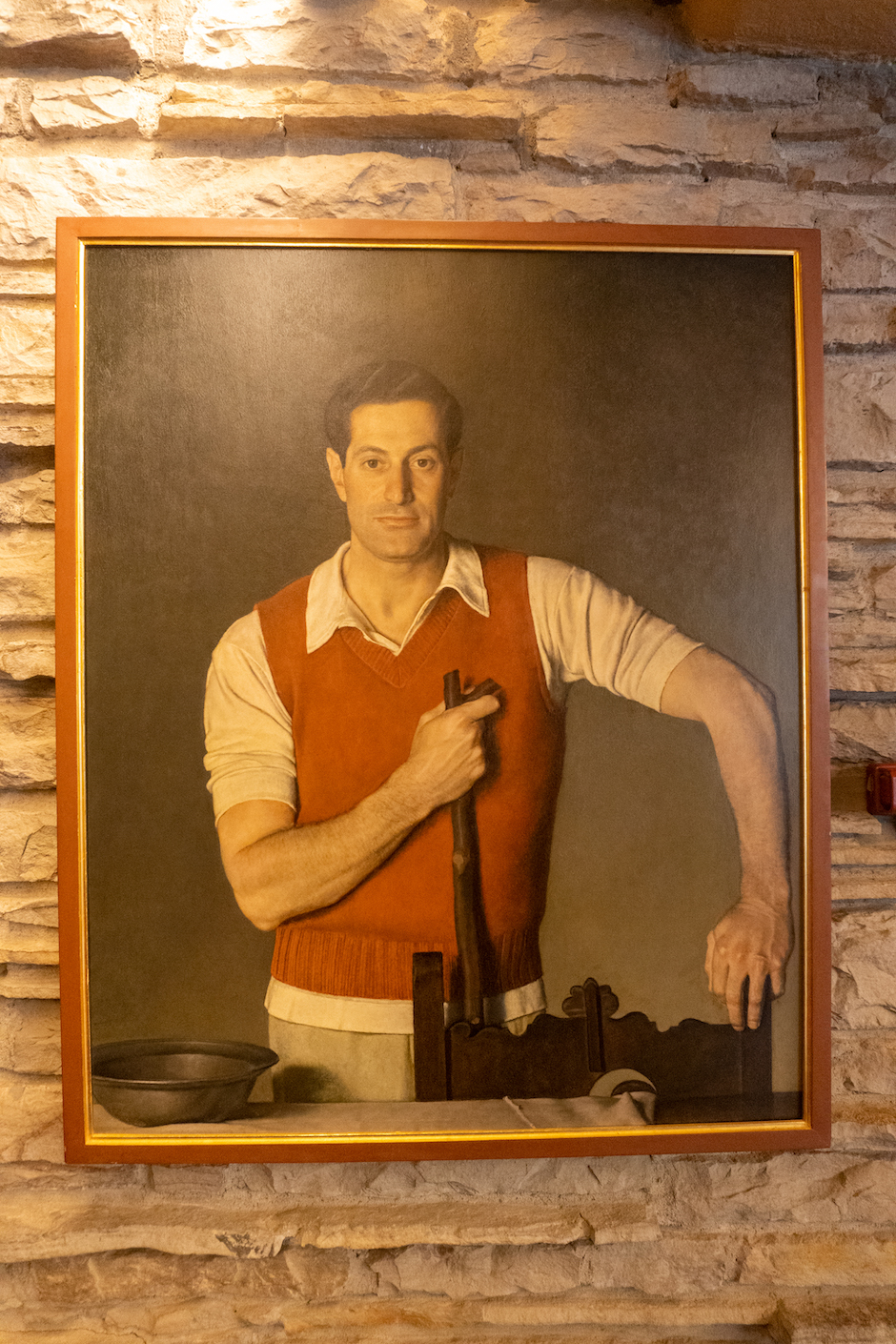
On our walk we learned about the family that hired Wright to build the house in the 1930’s the owners of Kauffman’s department store in Pittsburg. Although I had qualms about them spending so much money on this project in the midst of the Great Depression, I was also grateful for their forward thinking to support experimentation while many rich magnets of the time were investing in classical or ornate architecture. As a vacation house Fallingwater served the greater purpose of offering the experience of relaxation. This was a version of roughing it in the woods. Just fancier then our tent.
We stopped at the little river named Bear Run. This peaceful slow flowing river would shortly be taking one of the most monumental journeys in architecture history. It would make its way through the house and cascade out the other side creating the famous waterfall. It will be captured in hundreds of photos on the other end.

A bit further down the path the guide quickly rushed us past the bridge by the entry probably hoping we didn’t notice the construction noise with workmen and exposed steel scattered about. Not quite the curb appeal that I had expected. Having worked in the Sullivan office early in his career Wright was familiar with the engineering of concrete and steel materials for commercial buildings and was one of the first to gracefully translate that knowledge into his residential structures. This allowed him to design forms that seamlessly melded with nature. However, with the experimentation with materials there were also challenges. Therefore, there is always a part of the house that is being refurbished in order to be preserved.

As we approached the main entrance of the house, we saw on original soap on a rope hanging by the doorway and ceramic sculptures embedded in a fountain. Stairs lead down to a plunge pool of water from the river for cooling off in summer. We stood on the living room balcony and my first observation was the transparency of the house. From the outside I wasn’t looking inside but through it to the other side. The mist, the dew, the fog rising from below blurring the inside and out. All a part of the experience I had not expected.

At the main entrance I turned the cold metal door handle the only detail that could be touched. We entered into the living room where the ceilings and furnishings felt low to the ground and compressed but not constricted because of all of the expanses of windows. Weather was omnipresent with raindrops pounding down on the glass walls and outcrops of the ceiling above. Being in this house was existing with the day’s climate.
I heard the waterfall loud and clear. It was almost too loud. I wondered if it kept the inhabitants up at night or put them gently to sleep. I repeatedly looked for a glimpse of the waterfall from the house and I recognized that it could barely be seen. It is the magical question of Fallingwater. What sparked the thought in Wright to put the house on top of the falls instead of looking at it from the distance?

With many of the original furnishings intact I appreciated the details. The connections, patterns, portraits, wall hangings sculptures both spiritual and modern decoration. Warm woods and soft fabrics were set against the natural and uneven textures. The rock interiors all quarried from the site extending to the balcony. The glossy stone floor mimicking the wetness of the waterfall and the rainy day. The original stones at the base of the fireplace for sitting predating the house. They were the family’s favorite spot for watching the waterfall and a starting point for the design. Once the house was built, they must have been warmed by the flames, and comforting in winter. The warm micro palettes of colors reds, oranges, yellows, and rust bounced off the landscape and punctuated the connection to the outside.
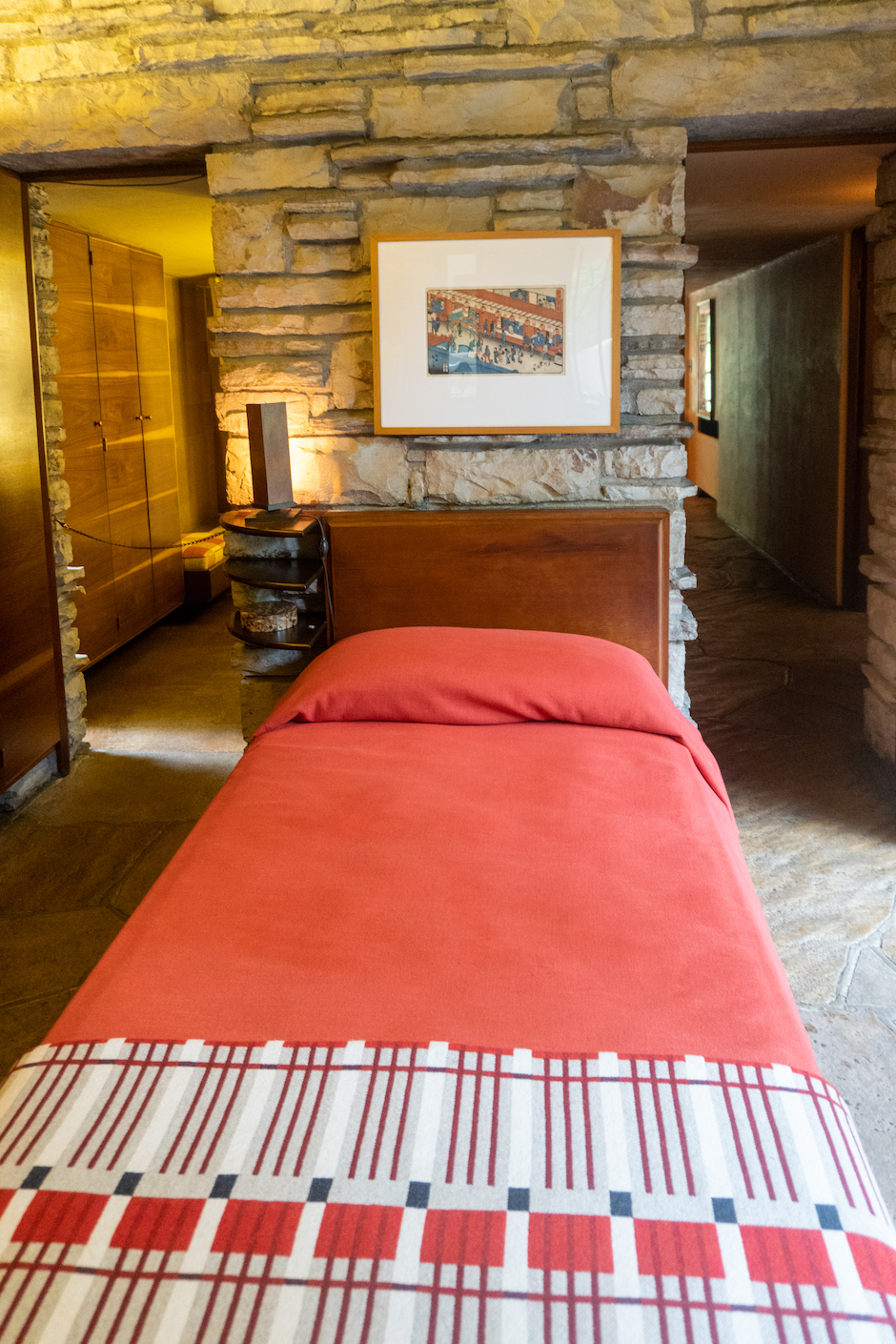
In the rain we moved up and down the lines of the architecture on steps indoors and out over and over exploring the different levels. Shelter and exposure, wet and then dry. The terraces and bedrooms places of retreat, the unimportant kitchen, the guest house, the outdoor swimming pool. Concrete molded like plastic around rocks covered with moss and ferns intimately tying together the architecture and nature. Cantilevers, cantilevers, and more cantilevers.
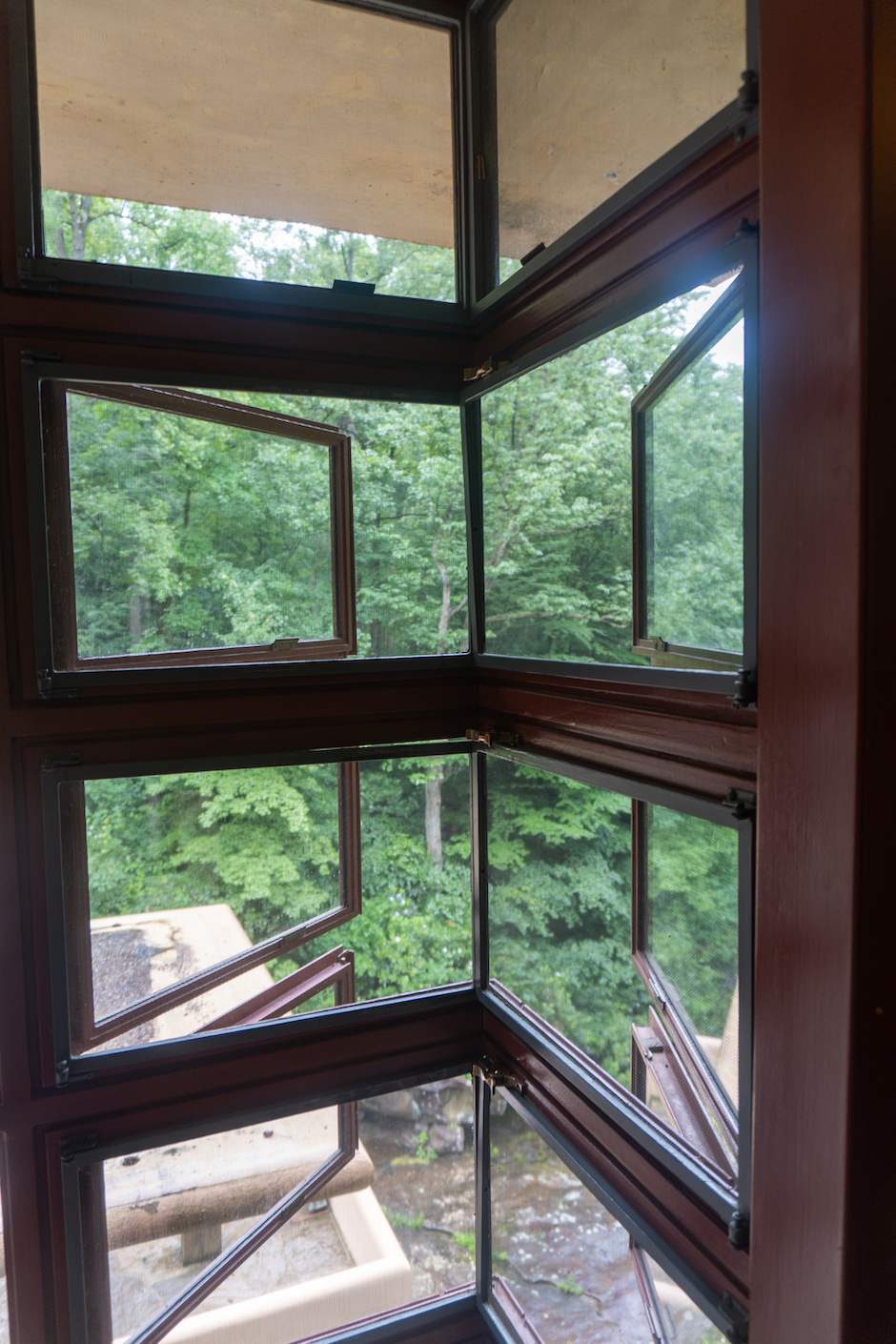
The tower windows opening up and meeting in the center framing the most dramatic views of the outdoor landscapes as well as rocks that cascaded down the hills looking like sculptures intentionally placed.

After our walk through the house, we spent the rest of the time exploring some of the 5000-acre area around the house in the rain. We walked up and down the hills through the landscape observing the foliage soaking in the rain and supporting the weight of the drops. We viewed the house from a distance a many different angles each time noticing extended horizontals juxtaposing each other and jutting out in many different directions. Shapes and patterns completely integrated into the organic setting. It made me realize that what I was seeing was living landscape. Every day people the people who take care of the grounds were also contributors to framing of my experience.

The dramatic impact the rain had on our visit made me wonder how the environment evolved around the house with the subtle changes in weather. How did it react to heat, snow, ice, and the colors of fall? I am glad we got to see the house on a day that the rain was extreme, the dampness rough on its systems and pushing its limits. All buildings must be left out in the rain and it is how they react that makes them stand apart. Our classic Fallingwater view was not picture postcard perfect but captured the essence of our personalized experience. That was only possible by being there.
